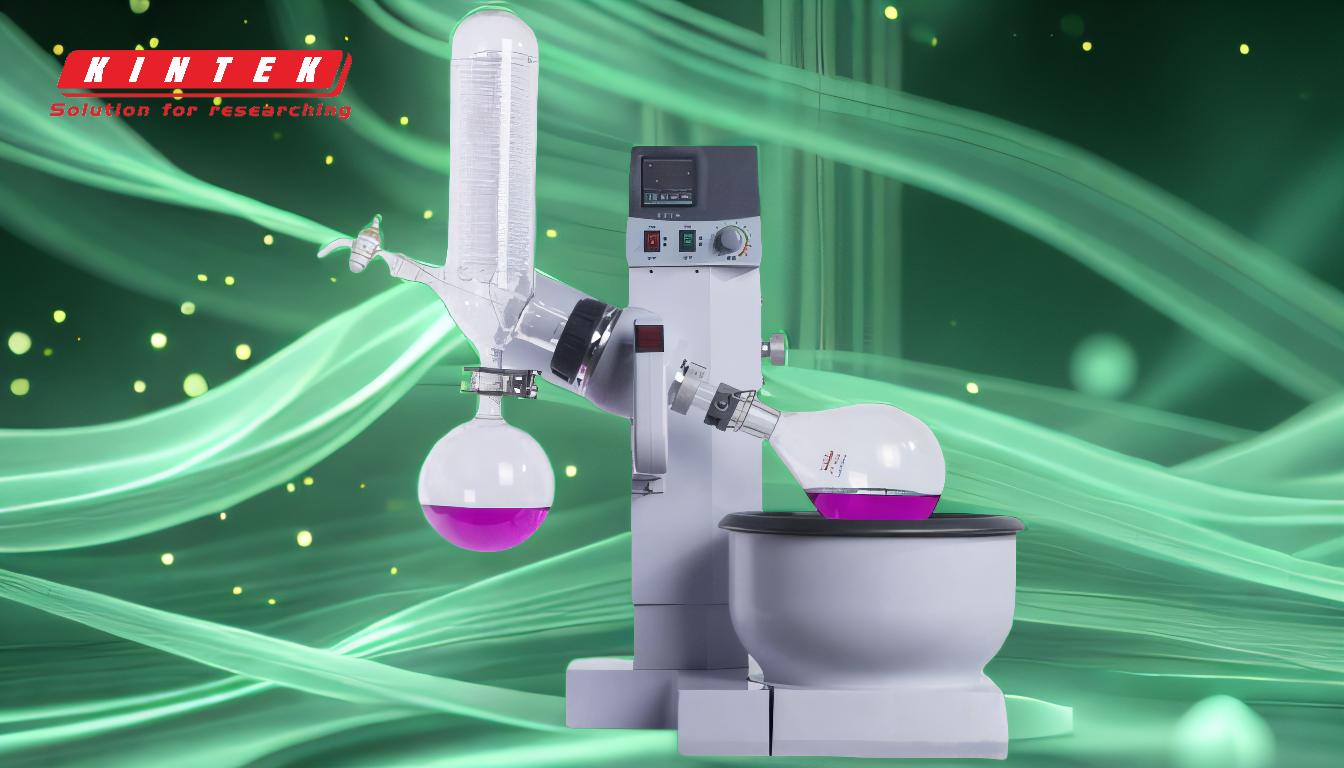Simple distillation is a fundamental technique used to separate liquids with significantly different boiling points. It involves heating a liquid mixture to its boiling point, collecting the vapor, and condensing it back into a liquid in a separate container. This process is particularly useful for purifying liquids or separating components in a mixture where the boiling points differ by at least 70°C. The setup is relatively straightforward, consisting of essential components like a distillation flask, a heat source, a condenser, and a receiving flask. Below, the key components and their roles in a simple distillation setup are explained in detail.
Key Points Explained:

-
Distillation Flask
- The distillation flask (often a round-bottom flask) holds the liquid mixture to be distilled.
- It is designed to withstand heat and is typically made of heat-resistant glass.
- The flask is connected to the condenser via a connecting tube or adapter.
-
Heat Source
- A heat source, such as a heating mantle, hot plate, or Bunsen burner, is used to heat the liquid mixture to its boiling point.
- The heat source must provide consistent and controllable heat to ensure even boiling and prevent overheating.
-
Thermometer
- A thermometer is inserted into the distillation flask or attached to the setup to monitor the temperature of the vapor.
- This helps ensure that the desired component is being distilled and prevents overheating of the mixture.
-
Condenser
- The condenser cools the vapor, converting it back into a liquid.
- It typically consists of a glass tube with an outer jacket through which coolant (usually water) flows.
- The vapor enters the condenser, cools, and exits as a liquid.
-
Receiving Flask
- The receiving flask collects the condensed liquid (distillate).
- It is placed at the end of the condenser to ensure all distillate is captured.
-
Connecting Tubes and Adapters
- Glass adapters and tubes connect the distillation flask, condenser, and receiving flask.
- These components ensure a sealed system to prevent vapor loss and maintain the integrity of the distillation process.
-
Cooling System
- A cooling system, often a water chiller or tap water, circulates coolant through the condenser to facilitate vapor condensation.
-
Safety Equipment
- Safety equipment, such as clamps and stands, secures the glassware to prevent spills or breakage.
- Heat-resistant gloves and goggles are recommended to protect against heat and glassware accidents.
Detailed Explanation of the Process:
-
Setup Assembly
- The distillation flask is filled with the liquid mixture and connected to the condenser using an adapter.
- The condenser is connected to the receiving flask, and the entire setup is secured with clamps and stands.
- The thermometer is positioned to monitor the vapor temperature.
-
Heating the Mixture
- The heat source is turned on, and the liquid mixture is gradually heated to its boiling point.
- The component with the lower boiling point vaporizes first, while the higher-boiling component remains in the flask.
-
Vapor Condensation
- The vapor travels through the connecting tube into the condenser, where it is cooled and condensed into a liquid.
- The coolant flowing through the condenser jacket ensures efficient cooling.
-
Collection of Distillate
- The condensed liquid (distillate) flows into the receiving flask.
- The process continues until the desired component is fully distilled or the temperature rises significantly, indicating the presence of the higher-boiling component.
-
Post-Distillation Cleanup
- Once distillation is complete, the heat source is turned off, and the setup is allowed to cool.
- The distillate is carefully collected, and the glassware is cleaned for future use.
Applications of Simple Distillation:
- Purification of Water: Removing salts and impurities from water.
- Separation of Solvents: Isolating solvents like ethanol from water.
- Essential Oil Extraction: Extracting essential oils from plant materials.
Advantages of Simple Distillation:
- Simplicity: Easy to set up and operate.
- Cost-Effective: Requires minimal equipment.
- Efficiency: Effective for separating liquids with large boiling point differences.
Limitations of Simple Distillation:
- Limited Separation: Not suitable for mixtures with similar boiling points.
- Purity: Provides moderate purity, as some mixing of components may occur.
- Energy Consumption: Requires continuous heating, which can be energy-intensive.
By understanding the components and process of simple distillation, users can effectively separate and purify liquids with distinct boiling points, making it a valuable technique in both laboratory and industrial settings.
Summary Table:
| Component | Role |
|---|---|
| Distillation Flask | Holds the liquid mixture, made of heat-resistant glass. |
| Heat Source | Provides consistent heat to boil the mixture. |
| Thermometer | Monitors vapor temperature to ensure proper distillation. |
| Condenser | Cools vapor into liquid using coolant. |
| Receiving Flask | Collects the condensed liquid (distillate). |
| Connecting Tubes | Seals the system to prevent vapor loss. |
| Cooling System | Circulates coolant for efficient condensation. |
| Safety Equipment | Secures the setup and protects against heat and glassware accidents. |
Need help setting up a simple distillation system? Contact our experts today for personalized guidance!











